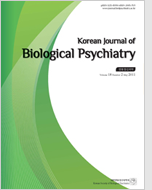
- Past Issues
- e-Submission
-

2021 Impact Factor 1.766
5-Year Impact Factor 1.674
Editorial Office
- +82-01-9989-7744
- kbiolpsychiatry@gmail.com
- https://www.biolpsychiatry.or.kr/

2021 Impact Factor 1.766
5-Year Impact Factor 1.674
Korean Journal of Biological Psychiatry 2010;17(3):153-60. Published online: Mar, 1, 2010
Objectives:Recurrence of mood episodes associated with a specific season has been described in various mood disorders. Seasonal change in mood and behavior as a lifetime trait is also observed in healthy individuals. This study aimed at comparing the lifetime trait of seasonal variations of mood and behavior between bipolar disorder patients and controls as well as investigating associated factors of seasonality.
Methods:Subjects were ninety-four clinically stable patients with bipolar disorder and 188 age- and sex-matched healthy controls. Seasonality of mood and behavior was assessed retrospectively on lifetime basis using Seasonal Pattern Assessment
Questionnaire(SPAQ).
Results:The patient group showed a higher median global seasonality score(GSS) of SPAQ and a higher rate of seasonal affective disorder(SAD) compared to the control group(p < 0.0001). For subjects showing prominent seasonality, the seasonal symptom profile and seasonal pattern was similar in both patient and control groups. In addition to the diagnosis, female gender was shown to be a predictor of seasonality in the multiple linear regression analysis(p = 0.045).
Conclusion:This study suggests that lifetime trait of seasonality may be related to the susceptibility of bipolar
disorder.
Keywords Seasonality;Seasonal Pattern Assessment Questionnaire(SPAQ);Bipolar disorder;Associated factors.